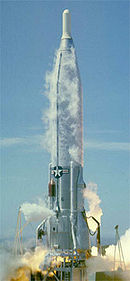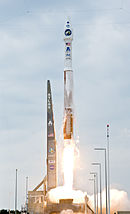Atlas C
| ||
 | ||
| Państwo | ||
| Producent | Convair | |
| Inne nazwy | SM-65C, XSM-65C | |
| Typ | ICBM | |
| Przeznaczenie | pocisk eksperymentalny | |
| Status | wycofany | |
| Lata służby | 1958–1959 | |
| Długość | 25,15 m | |
| Średnica | 3,05 m | |
| Rozpiętość | 4,88 m | |
| Masa startowa | 110 740 kg | |
| Prędkość | 29 030 km/h | |
| Zasięg | 8000 km | |
| Udźwig | 70 kg | |
| Celność | CEP: 3,23 km | |
Atlas C (oznaczenie SM-65C) – ostatni eksperymentalny wariant pocisku balistycznego serii Atlas. Wykorzystywany w latach 1958–1959. Odbył 6 lotów balistycznych, z czego trzy zakończyły się pełnym sukcesem. Później został użyty jako 1. człon rakiety Atlas C Able, jednak jedyny egzemplarz tej rakiety eksplodował we wrześniu 1959 podczas naziemnych testów statycznych na platformie startowej. Pocisk został wycofany na rzecz pocisku Atlas D, przekonfigurowanego w latach 60. na rakietę nośną.
Zobacz też
Bibliografia
- Mark Wade: Atlas C. Encyclopedia Astronautica. [dostęp 2017-06-14].
- Gunter Krebs: Atlas-C (XSM-65C) ICBM (ang.). W: Gunter's Space Page [on-line]. [dostęp 2017-06-14].
| ||||||||||||||||||||||||||||||||||||||||||||||||||||
Media użyte na tej stronie
The flag of Navassa Island is simply the United States flag. It does not have a "local" flag or "unofficial" flag; it is an uninhabited island. The version with a profile view was based on Flags of the World and as a fictional design has no status warranting a place on any Wiki. It was made up by a random person with no connection to the island, it has never flown on the island, and it has never received any sort of recognition or validation by any authority. The person quoted on that page has no authority to bestow a flag, "unofficial" or otherwise, on the island.
Atlas C missile sitting on its launch pad
Trailing a column of fire, the Atlas V(401) carrying NASA's Lunar Reconnaissance Orbiter, or LRO, and NASA's Lunar Crater Observation and Sensing Satellite, known as LCROSS, hurtles off Launch Complex 41 at Cape Canaveral Air Force Station in Florida. LRO and LCROSS are the first missions in NASA's plan to return humans to the moon and begin establishing a lunar outpost by 2020. The LRO also includes seven instruments that will help NASA characterize the moon's surface: DIVINER, LAMP, LEND, LOLA , CRATER, Mini-RF and LROC. Launch was on-time at 21:32 UTC.
Atlas 3F prior to failed launch attempt





